Figure shows an equiconvex lens (of refractive index 1.50) in contact with a liquid layer on top of a plane mirror. A small needle with its tip on the principal axis is moved along the axis until its inverted image is found at the position of the needle. The distance of the needle from the lens is measured to be 45.0 cm. The liquid is removed and the experiment is repeated. The new distance is measured to be 30.0 cm. What is the refractive index of the liquid ?
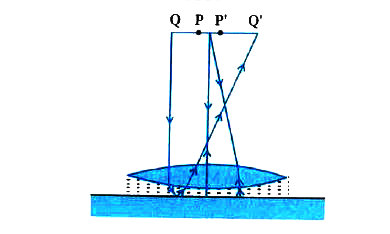 Solution in Gujrati
Solution in Gujrati
⇒ Suppose, focal length of convex lens f1=30 cm and focal length of plano concave lens of liquid f2 and focal length of combination F = 45.0 cm
⇒ Focal length of combination,
1F=1f1+1f2
∴1f2=1F−1f1
∴1f2=145−130=2−390=−190
∴f2=−90cm
⇒ For glass lens, suppose R1=R,R2=−R
1f1=(μ−1)[1R1−1R2]
130=[32−1][1R−1−R]
130=12×2R
∴R=30cm
⇒ For lens of liquid,
f2=−90cm,R1=−R=−30cm and R2=∞
∴ Lens maker.s formula,
1f2=(μl−1)[1R1−1R2]
1−90=(μl−1)[1−R−1∞]
1−90=(μ1−1)[1−R][∵1∞=0]
∴1−90=(μ1−1)[1−30]
∴μl−1=13
∴μl=43=1.33
Topper's Solved these Questions
- BOOK - KUMAR PRAKASHANCHAPTER - RAY OPTICS AND OPTICAL INSTRUMENTSEXERCISE - SECTION-B (NUMERICALS)(NUMERICAL FROM .DARPAN. BASED ON TEXTBOOK )12videos
RAY OPTICS AND OPTICAL INSTRUMENTS
- BOOK - KUMAR PRAKASHANCHAPTER - RAY OPTICS AND OPTICAL INSTRUMENTSEXERCISE - SECTION-C (NCERT EXEMPLAR SOLUTION) (MULTIPLE CHOICE QUESTIONS (MCQs))16videos
RAY OPTICS AND OPTICAL INSTRUMENTS
- BOOK - KUMAR PRAKASHANCHAPTER - RAY OPTICS AND OPTICAL INSTRUMENTSEXERCISE - SECTION-B (NUMERICALS)(NUMERICAL FROM TEXTUAL ILLUSTRATIONS)17videos
RAY OPTICS AND OPTICAL INSTRUMENTS
- BOOK - KUMAR PRAKASHANCHAPTER - MOVING CHARGES AND MAGNETISMEXERCISE - SECTION D (MCQs ASKED IN COMPETITIVE EXAMS)34videos
MOVING CHARGES AND MAGNETISM
- BOOK - KUMAR PRAKASHANCHAPTER - SAMPLE QUESTION PAPER EXERCISE - PART-B SECTION-C5videos
SAMPLE QUESTION PAPER
Similar Questions
As shown in the figure, a thin rod AB of length 10 cm is placed on the principal axis of a concave mirror such that it.s end B is at a distance of 40 cm from the mirror. If the focal length of the mirror is 20 cm, find the length of the image of the rod
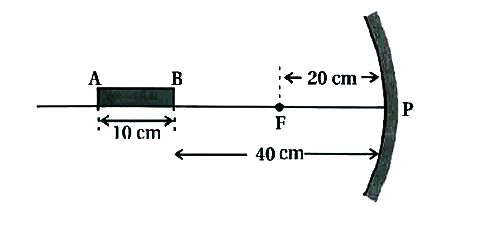 06:04View Solution
06:04View SolutionA ray of light incident at an angle θ on a refracting face of a prism emerges from the other face normally. If the angle of the prism is 5∘ and the prism is made of a material of refractive index 1.5, the angle of incidence is
07:04View SolutionSuppose that the lower half of the concave mirror.s reflecting surface as shown in figure is covered with an opaque (non-reflective) material. What effect will this have on the image of an object placed in front of the mirror ?
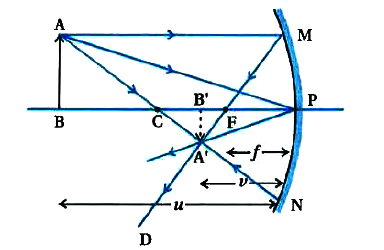 07:04View Solution
07:04View SolutionElectric charge Q having mass M moves on a circular path of radius R with velocity →v, perpendicular to uniform magnetic field B. When a particle completes one revolution, work done by the field is _______
View SolutionTwo charges –q and +q are located at points (0, 0, –a) and (0, 0, a), respectively.
(a) What is the electrostatic potential at the points (0, 0, z) and (x, y, 0) ?
(b) Obtain the dependence of potential on the distance r of a point from the origin when r/a>>1 .
(c) How much work is done in moving a small test charge from the point (5,0,0) to (–7,0,0) along the x-axis? Does the answer change if the path of the test charge between the same points is not along the x-axis?View SolutionA thin equiconvex lens of refractive index 3//2 is placed on a horizontal plane mirror as shown in figure. The space between the lens and the mirror is filled with a liquid of refractive index 4//3 . It is found that when a point object is placed 15 cm above the lens on its priincipal axis, the object coincides with its own image. Q. If another liquid is filled instead of water, the object and the image coincide at a distance 25 cm from the lens. Calculate the refractive index of the liquid.
15:54View SolutionAn equiconvex lens with radii of curvature of magnitude R each is put over a liquid layer poured on top of a plane mirror. A small needle, with its tip on the principal axis of the lens, is moved along the axis until its inverted real image coincides with the needle itself. The distance of the needle from the lens is measured to be 'a'. On removing the liquid layer and repeating the experiment the distance is found to be 'b'.
Given that the two values of distances measured represent the focal length values in the two cases, obtain a formula for the refractive index of the liquid.
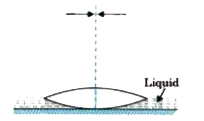 08:02View Solution
08:02View SolutionAn equiconvex lens with radii of curvature of magnitude R each is put over a liquid layer poured on top of a plane mirror. A small needle, with its tip on the principal axis of the lens, is moved along the axis until its inverted real image coincides with the needle itself. The distance of the needle from the lens is measured to be 'a'. On removing the liquid layer and repeating the experiment the distance is found to be 'b'.
Given that the two values of distances measured represent the focal length values in the two cases, obtain a formula for the refractive index of the liquid.
 06:40View Solution
06:40View SolutionA lens when placed on a plane mirror then object needle and its image coincide at 15 cm . The focal length of the lens is
15:54View SolutionAn equiconvex lens, with redii of curvature of magnitude 10 cm each, is put over a liquid layer poured on top of a plane mirror. A small needle, with its tip on the principal axis of the lens, is moved along the axis until its inverted real image coincides with the needle itself. The distance of the needle, from the lens, is measured to be 15 cm . On removing the liquid layer, and repeating the experiment the distance is measured to be 10 cm . Given that the two values of the distance measured represent the force length values in the two cases, calculate the refractive index of the liqiud.
07:04View SolutionA synunetdc bionvex fens of radius of curvature Rand made of glass of refractive index 1.5, is placed on a placed on top of a plane mirror as shown in the figure.An optical needle with with its tip on the principal axis of the lens is moved along the axis until its real, inverted images conicides with the needle itself. The distance from the lens in measured to be x. On removing the liquid layer and repeating the experiment, the distance is found to be y . Obtain the expression for the refractive index of the liquid in terms of x and y.
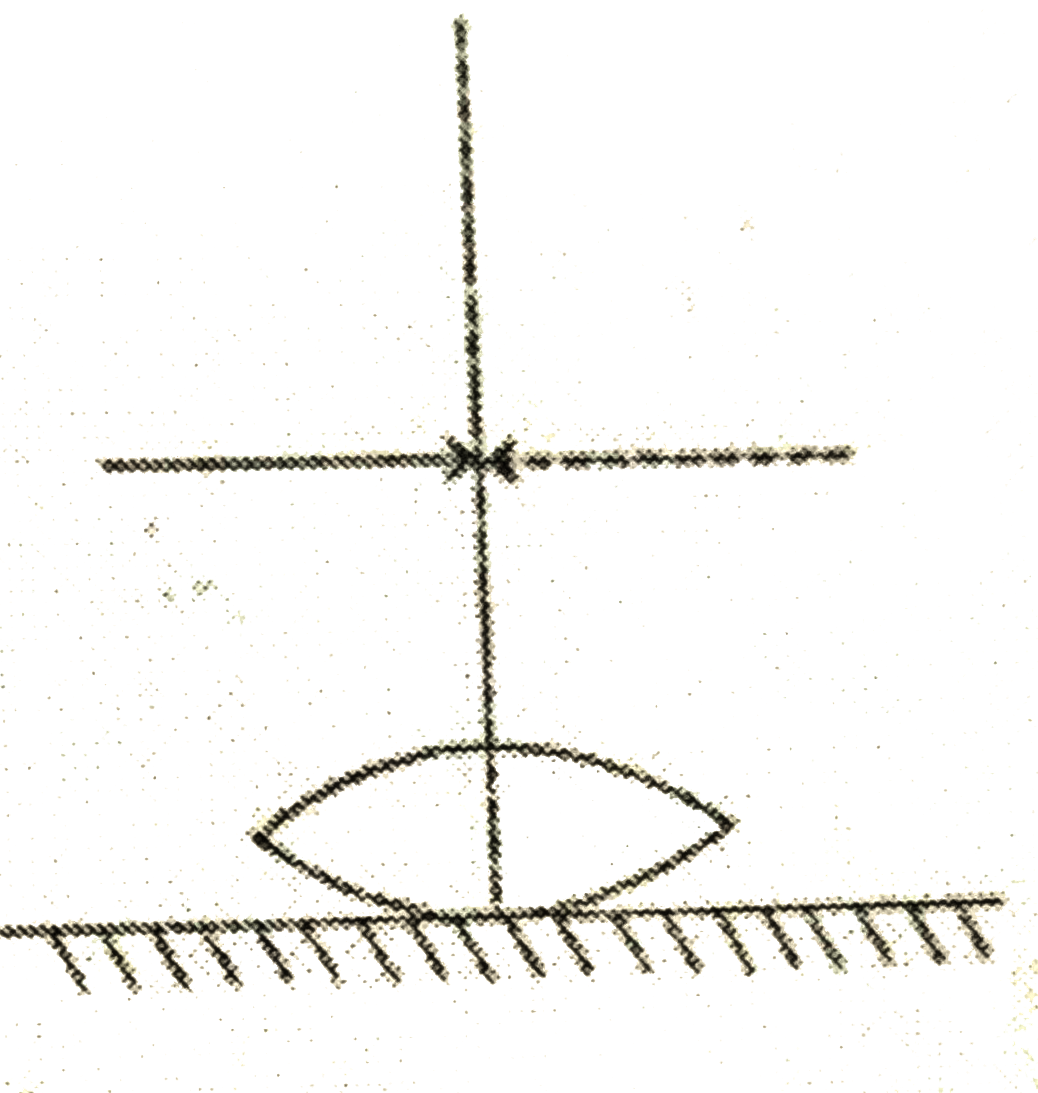 05:41View Solution
05:41View Solutionएक उत्तल लेंस जिनकी प्रत्येक वक्रता-त्रिज्या r है एक ऐसे समतल दर्पण पर रखा है जिसपर एक द्रव डाला हुआ है। एक छोटी सुई जिनकी नोंक लेंस के मुख्य अक्ष पर है, को अक्ष के अनुरेख तब तक चलाया जाता है जब तक इसका उलटा प्रतिबिंब सुई से मिल नहीं जाता। लेंस से सुई की दुरी 'a' मापी गई है। द्रव की परत को हटा देने पर और प्रयोग को दुहराने पर यही दुरी 'b' पाई जाती है। दिए गए आँकड़ों से द्रव के अपवर्तनांक के लिए व्यंजक व्युत्पन्न करें।
05:21View Solutionचित्र में कोई समोत्तल (equiconvex ) लेंस (अपवर्तनांक 1.50 ) किसी समतल दर्पण के फलक पर किसी द्रव की परत के संपर्क में दर्शाया गया है | कोई छोटी सुई जिसकी के अनुदिश ऊपर - नीचे गति कराकर इस प्रकार समायोजित की जाती है कि सुई की नोंक का उलटा प्रतिबिम्ब सुई की स्थिति पर ही बने | इस स्थिति में सुई की लेंस से दुरी 45 cm है | द्रव को हटाकर प्रयोग को दोहराया जाता है | नई दुरी 30 cm मापी जाती है | द्रव का अपवर्तनांक क्या है ?
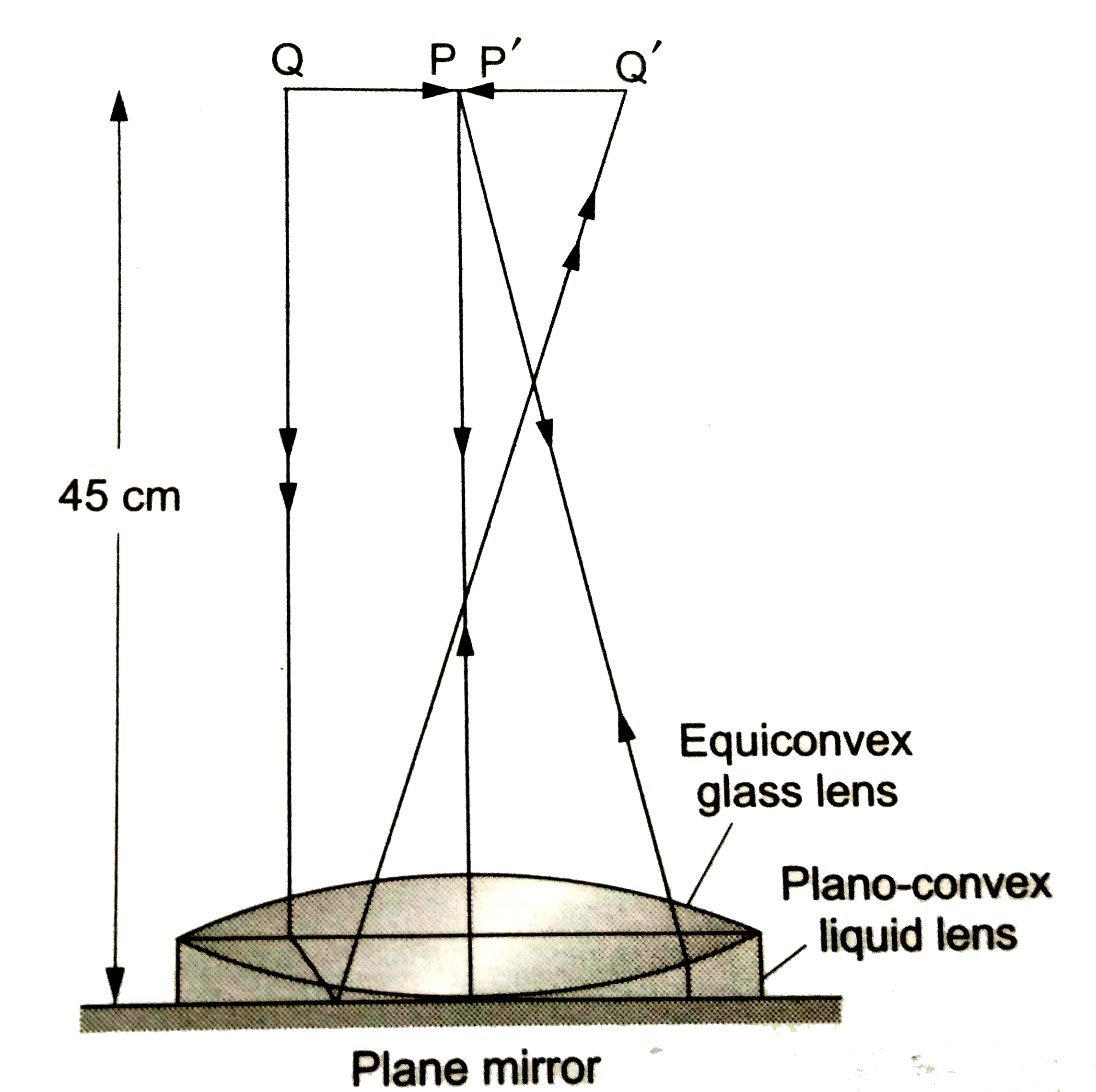 08:48View Solution
08:48View SolutionA symmetric biconvex lens of radius of curvature R and made of glass of refractive index . 15 is placed on a layer of liquid palced on top of a plane mirror as shown in the figure An optical needle with its tip on the principle axis of the lens is moved along the axis until its real , inverted image coinides with the needle itself . The distance of the needle from the lens is measured to be x. On removing the liquid layer and repeating the experiment, the distance is found to obey . obtain the expression for the refreactive index to the liquid in terms of x and y.
05:23View SolutionAn equiconvex lens with radii of curvature of magnitude R each is put over a liquid layer poured on top of a plane mirror. A small needle, with its tip on the principal axis of the lens, is moved along the axis until its inverted real image coincides with the needle itself. The distance of the needle from the lens is measured to be 'a'. On removing the liquid layer and repeating the experiment the distance is found to be 'b'.
Given that the two values of distances measured represent the focal length values in the two cases, obtain a formula for the refractive index of the liquid.
 04:38View Solution
04:38View SolutionA synunetdc bionvex fens of radius of curvature Rand made of glass of refractive index 1.5, is placed on a placed on top of a plane mirror as shown in the figure.An optical needle with with its tip on the principal axis of the lens is moved along the axis until its real, inverted images conicides with the needle itself. The distance from the lens in measured to be x. On removing the liquid layer and repeating the experiment, the distance is found to be y . Obtain the expression for the refractive index of the liquid in terms of x and y.
09:15View Solution

